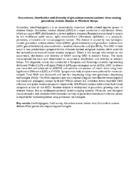| dc.description.abstract | Groundnut (ArachishypogaeaL.) is an economically important edible oilseed legume, grown in western Kenya. Groundnut rosette disease (GRD) is a major constraint in sub-Saharan Africa, which can cause 100% yield losses in a severe epidemic situation. Rosette is transmitted in nature by the viruliferous aphid vector, Aphis craccivoraKoch (Homoptera: Aphididae), in a polycyclic, persistent, circulative and non-propagative manner. The disease is caused by two synergistic viruses; groundnut rosette assistor virus (GRAV, genus Luteovirus) and groundnut rosette virus (GRV, genus Umbravirus) associated with a satellite-ribonucleic acid (Sat-RNA). The GRD viruses occur in two predominant symptom forms; chlorotic rosette and green rosette, which override the isolated occurrence of mosaic rosette symptom. There is not enough information on the occurrence, distribution and diversity of GRAV causing GRD in western Kenya. This study characterized the virus and determined its occurrence, distribution and diversity in western Kenya. The diagnostic survey was conducted in Bungoma and Kakamega counties representing the Lower Midland (LM) and Upper Midland (UM) agro-ecological zones (AEZs). GRD incidence was recorded and subjected to ANOVA and pairwise comparison of means done using Least Significance Difference (LSD) at P ≤ 0.05. Symptomatic leafy samples were collected for molecular analysis. Total RNA was extracted and sent for sequencing using next generation sequencing technologies (NGS). The RNA sequence data was analyzed using our own Bioinformatics pipeline and molecular phylogeny analysis by BLAST MEGA version 6.0. Individual farms recorded 100% chlorotic and green rosette symptoms respectively, 20% Mosaic rosette while others had mixed symptoms across all the AEZs. Rosette disease is widespread in groundnut growing areas of western Kenya, due to inadequate potential based cropping systems. Molecular and biological characterization with extensive field evaluation surveys of groundnut isolates and indicator plants, is required for harnessing better crop protection technologies. | en_US |

